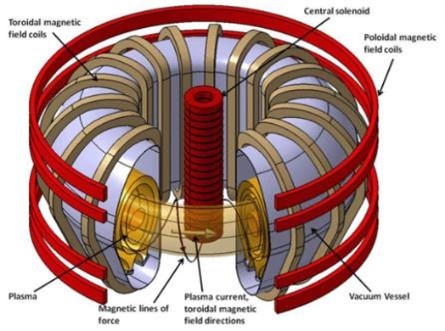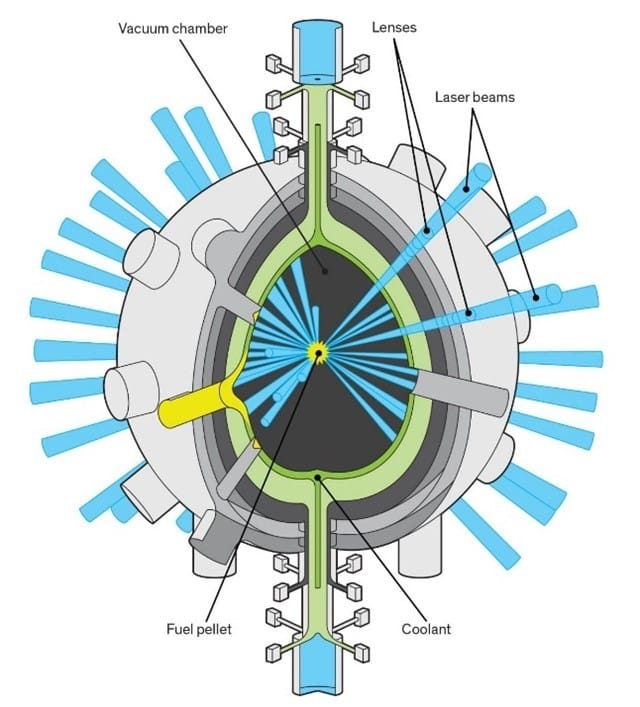
On December 13, 2022, physicists at the U.S. government-funded National Ignition Facility (NIF) at Lawrence Livermore National Laboratory in California announced that for the first time a powerful fusion reactor had briefly generated more energy than was put into it. They were able to fire a laser carrying roughly two megajoules of energy into a tiny fuel pellet made up of two hydrogen isotopes, turning the atoms into plasma and producing three megajoules of energy — a 50-percent increase.
However, the reporting of this event turns out to be very misleading. The new plasma ignition milestone only accounts for the laser energy into and the plasma energy out of the target. It does not account for the 300 megajoules of energy that was required to power the lasers — that is, the energy required to convert electricity to laser light.
The reactor did not produce a net gain of energy. For a fusion reaction to be practically useful, the energy drawn from the electrical grid to initiate the fusion reaction would have to be significantly less than the energy released from the plasma.
A Practical Look at Fusion
Let’s back up just a bit to address some fusion fundamentals. Fusion research technically began in the 1920s, so we are approaching 100 years of fusion research and development. The huge technical problem is maintaining a mass of plasma at a temperature of several million degrees to enable fusion, while extracting enough heat to provide useful energy. The two main approaches for trying to make fusion a viable source of energy are called magnetic confinement and inertial confinement. Magnetic confinement attempts to use very powerful magnets to confine a superheated plasma in which fusion reactions can occur continuously. The most common magnetic confinement scheme is the tokamak, seen below.

Tokamak reactors aim to keep the plasma continuously burning for prolonged periods of time. Despite edging ever closer, they have yet to create a net energy gain from their plasmas.
The principle of inertial confinement is to induce a shockwave in a deuterium-tritium (DT) target creating a sufficiently high temperature and density to initiate fusion. (Deuterium, or hydrogen-2, is a stable isotope of hydrogen whereas tritium, or hydrogen-3, is a radioactive isotope of hydrogen.)
Laser-driven inertial confinement (shown below) uses an intense set of laser beams to compress the target atoms sufficiently to achieve a fusion reaction.

Inertial confinement systems generate bursts of energy by quickly burning one tiny chunk of fuel after another. This fuel comes in the form of discrete pellets, and scientists have yet to figure out how to replace them quickly enough to maintain a reaction for longer than the tiniest fraction of a second.
The NIF inertial confinement reaction lasts only a few billionths of a second and can only be repeated every six hours.
While nearly all stable isotopes lighter than iron and nickel will fuse with some other isotope and release energy, deuterium and tritium are by far the most attractive isotopes for energy generation. They require the lowest activation energy (thus lowest temperature) to do so while producing the most energy per unit weight.
The fusion energy gain factor, Q, is the ratio of fusion power produced to power required to maintain the plasma in a steady state. Scientific breakeven is defined as Q = 1, where the power released from the fusion reaction equals the power input to initiate the reaction. The December NIF event achieved an energy gain factor of about 1.5.
For engineering breakeven, one must get more power out of the fusion energy plant than one puts into the plant. In other words, the input power includes the power required for all of the engineering systems that make the fusion reaction possible. The energy gain factor for engineering breakeven is considered to be five to eight for magnetic confinement and 50 to 100 for inertial confinement. There is still a very long way to go to achieve engineering breakeven. We are nowhere near seeing the light at the end of the tunnel for this breakthrough.
Commercial Possibilities
Commercial breakeven is the Holy Grail, when the economic value of sold electricity is sufficient to pay for the plant that produces it. Despite what is being touted in the media, it is highly unlikely that commercial breakeven will be achieved in another hundred years of fusion R&D. Rod Adams, a Navy nuclear veteran who is a partner with the Nucleation Capital venture fund, told The Epoch Times, “Anyone who predicts commercial fusion before 2050 has a far greater imagination than I do.”
The same article quoted Daniel Jassby, a former research physicist with Princeton University’s plasma laboratory, who says that “it will take half a century to develop the presently non-existent technologies required for a power reactor based on [inertial confinement fusion], including a practical laser or ion beam.” In his view, even tokamaks remain “highly speculative.”



